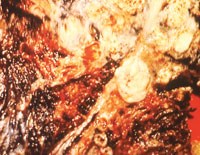STA-4783 plus standard therapy well-tolerated in non–small-cell lung cancer
The overall safety profile of STA-4783 is similar to that of paclitaxel and carboplatin alone.
PHILADELPHIA — The combination of STA-4783 (Synta Pharmaceuticals) plus paclitaxel and carboplatin has shown encouraging clinical activity and is well tolerated in patients with non–small-cell lung cancer (NSCLC), according to research presented here at the American Association for Cancer Research-National Cancer Institute-European Organization for Research and Treatment of Cancer International Conference on Molecular Targets and Cancer Therapeutics.
“Its overall safety profile appears similar to that of paclitaxel and carboplatin alone,” noted Thomas A. Dahl, MD, who also led the phase-1 studies of STA-4783.
STA-4783 is a novel heat shock protein 70 inducer, which significantly enhanced paclitaxel’s antitumor activity in preclinical models. Dahl and colleagues assessed IV paclitaxel and STA-4783, which they administered to patients over three hours every three weeks in a phase-1 trial.
Patients tolerated the combination, though researchers did not determine the maximum tolerated dose in the phase-1 setting. They recognized a potential of STA-4783 to improve outcomes in patients with NSCLC and initiated the current phase-2 trial in chemotherapy-naive patients.
Ongoing follow-up
The researchers created a two-stage trial design to assess the safety and efficacy of STA-4783 in patients with stage IIIB or IV NSCLC. In the first stage of the trial, Dahl assessed drug safety at different dosages.
| |
| Source: NCI |
He and his colleagues evaluated two dose levels in the first stage of the trial. One cohort of seven patients received carboplatin (area under the curve [AUC] = 6) with 175 mg/m2 of paclitaxel and 233 mg/m2 of STA-4783. A second cohort of nine patients received carboplatin (AUC = 6) with 200 mg/m2 of paclitaxel and 266 mg/m2 of STA-4783.
Patients in both cohorts received IV treatment every three weeks for up to six cycles, as long as clinicians did not reduce doses due to toxicity and patients did not progress. Patients in the second cohort tolerated treatment; therefore, Dahl and colleagues selected this dose level for the next stage of the study.
In the second stage of the study, researchers randomized 87 patients to receive carboplatin (AUC = 6), 200 mg/m2 of paclitaxel or carboplatin (AUC = 6) with 200 mg/m2 of paclitaxel and 266 mg/m2 of STA-4783. The primary endpoint was time to progression. Secondary endpoints were response rate, survival and quality of life.
No first cycle dose-limiting toxicities occurred in either cohort, according to the study, and observed adverse events were as expected at both dose levels. Expected adverse events included, but were not limited to, fatigue, anemia, neutropenia, alopecia, nausea, dyspnea, vomiting and anorexia.
Eleven patients completed six cycles of treatment. Forty-four percent achieved a partial response and 38% achieved disease stabilization, according to the Response Evaluation Criteria in Solid Tumors. Researchers are following patients for time to progression and overall survival.
Dahl is vice president of clinical development for Synta Pharmaceutical Corp. – by Rebekah Cintolo
For more information:
- Hainsworth J, Weber R, Jacobs M, et al. Results of a phase 2 study of STA-4783 in combination with paclitaxel and carboplatin in patients with previously untreated advanced non-small cell lung cancer (NSCLC). Abstract B112. Presented at: AACR-NCI-EORTC International Conference on Molecular Targets and Cancer Therapeutics; Nov. 14-18, 2005; Philadelphia.

